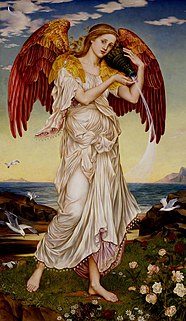
In Greek mythology, Eos is a Titaness and the goddess of the dawn, who rose each morning from her home at the edge of the Oceanus.
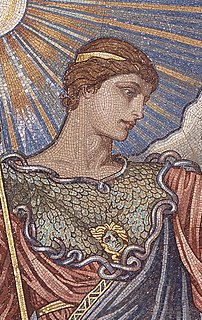
Minerva was the Roman goddess of wisdom and strategic warfare and the sponsor of arts, trade, and strategy. From the second century BC onward, the Romans equated her with the Greek goddess Athena, though the Romans did not stress her relation to battle and warfare as the Greeks did.

Ariadne, in Greek mythology, was a Cretan princess. She is mostly associated with mazes and labyrinths because of her involvement in the myths of the Minotaur and Theseus.
In Roman mythology, Cloacina, "The Cleanser" was the goddess who presided over the Cloaca Maxima, the main trunk of the system of sewers in Rome. She was originally derived from Etruscan mythology. The Cloaca Maxima was said to have been begun by Tarquinius Priscus, one of Rome's Etruscan kings, and finished by another, Tarquinius Superbus.
Artume was an Etruscan goddess who was the mistress of animals, goddess of human assemblies and hunting deity of Neolithic Origin. She was associated with the Greek goddess Artemis in later history. Aritimi was also considered the founder of the Etruscan town Aritie, which is today the Italian town Arezzo.

Menrva was an Etruscan goddess of war, art, wisdom, and medicine. She contributed much of her character to Roman Minerva, when that culture evolved. She was the child of Uni and Tinia.
In Etruscan religion and myth, Thalna was a divine figure usually regarded as a goddess of childbirth. Determinate gender, however, is not necessarily a characteristic of Etruscan deities, and Thalna is also either depicted as male, or seems to be identified as a male figure because of the placement of names around a scene. Her other functions include friendship and prophecy. Her name may mean "growth, bloom." She appears in Etruscan art in the company of Turan, Tinia, and Menrva.

In Etruscan mythology, Thesan was the Etruscan Goddess of the dawn, divination and childbirth and was associated with the generation of life. She was identified with the Roman Aurora and Greek Eos.
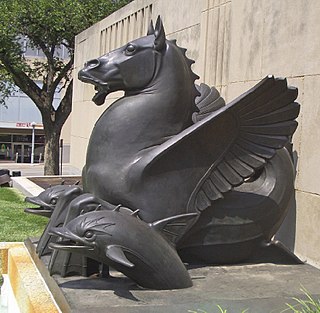
The hippocampus or hippocamp, also hippokampoi, often called a sea-horse in English, is a mythological creature shared by Phoenician, Etruscan, and Greek mythology, though its name has a Greek origin. The hippocampus has typically been depicted as having the upper body of a horse with the lower body of a fish.
In Roman and Etruscan mythology, Mania was a goddess of the dead. She, along with Mantus, ruled the underworld. She was said to be the mother of ghosts, the undead, and other spirits of the night, as well as the Lares and the Manes. Her name links her to the Manes, Mana Genita, and Manius.
Albina was an Etruscan goddess. She was a white sow goddess similar to the Celtic Ceridwen.

Turan was the Etruscan goddess of love, fertility and vitality and patroness of the city of Velch.

Uni was the supreme goddess of the Etruscan pantheon and the patron goddess of Perugia. Uni was identified by the Etruscans as their equivalent of Juno in Roman mythology and Hera in Greek mythology. She formed a triad with her husband Tinia and daughter Menrva.
Mythology of Italy refers to the mythology of people living in Italy.

Raet(rˁỉ.t) or Raet-Tawy/Taui(rˁỉ.t-tꜣ.wỉ) is an ancient Egyptian solar goddess, the female aspect of Ra. Her name is simply the female form of Ra's name; the longer name Raet-Tawy means "Raet of the Two Lands".
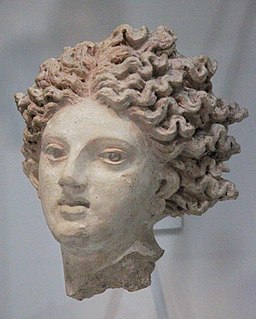
Catha is a female Etruscan lunar or solar deity, who may also be connected to childbirth, and has a connection to the underworld. Catha is also the goddess of the south sanctuary at Pyrgi, Italy. She is often seen with the Etruscan god Śuri with whom she shares a cult. Catha is also frequently paired with the Etruscan god Fufluns, who is the counterpart to the Greek god Dionysus, and Pacha, the counterpart to the Roman god Bacchus. Additionally, at Pyrgi, Catha is linked with the god Aplu, the counterpart to the Greek god Apollo. Aplu may have even taken some of the characteristics of Catha when he was brought into the Etruscan religion. Giovanni Colonna has suggested that Catha is linked to the Greek Persephone since he links Catha’s consort, Suri, to Dis Pater in Roman mythology.
Leinth is an Etruscan deity. Within Etruscan iconography, it is difficult to distinguish mortals from divine figures without inscriptions. Inscriptions to the god Leinth have only been identified on two bronze mirrors and a single fragment of ceramic, found within an artisan’s zone on an Etruscan site in Italy. It is difficult, with such little evidence, to determine what may seem to be even the most rudimentary qualities of the deity, because the Etruscans did not consistently assign specific genders or attributes to their gods. Leinth appears both as a male and a female on two different bronze mirrors, and aside from the inscription, there seem to be no distinguishing traits to connect the figures.
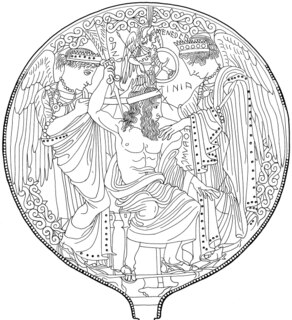
Ethausva is an Etruscan divine figure that appears in a few Etruscan inscriptions. She is depicted as a winged female richly robed and wearing a jeweled crown on her head. Her lack of mention on Etruscan artwork and inscriptions suggest that she was not very common, but she was considered canon to the Etruscan Pantheon so she was still known during the time of the Etruscans.

The City of New York, usually called either New York City (NYC) or simply New York (NY), is the most populous city in the United States and thus also in the state of New York. With an estimated 2017 population of 8,622,698 distributed over a land area of about 302.6 square miles (784 km2), New York is also the most densely populated major city in the United States. Located at the southern tip of the state of New York, the city is the center of the New York metropolitan area, the largest metropolitan area in the world by urban landmass and one of the world's most populous megacities, with an estimated 20,320,876 people in its 2017 Metropolitan Statistical Area and 23,876,155 residents in its Combined Statistical Area. A global power city, New York City has been described as the cultural, financial, and media capital of the world, and exerts a significant impact upon commerce, entertainment, research, technology, education, politics, tourism, art, fashion, and sports. The city's fast pace has inspired the term New York minute. Home to the headquarters of the United Nations, New York is an important center for international diplomacy.














